The United States Forest Service issued the following notice regarding the Ray Mica Mine.
Release Date: Aug 26, 2011
Contact(s): Stevin Westcott, (828) 257-4215
BURNSVILLE, N.C. – The USDA Forest Service National Forests in North Carolina announced the permanent closure of 11 abandoned mine shafts at the Ray Mines area in Yancey County, N.C., to promote public safety and protect bats and other forest resources. “Public safety is our number one priority at the Forest Service,” said Tina Tilley, ranger of the Appalachian District in the Pisgah National Forest. “Closing the abandoned mine shafts to the public will restrict access and make the area safer for recreational users, while providing environmental benefits such as preventing the spread of deadly white nose syndrome to local bats and protecting water quality. It is important to note that my decision to close the shafts will not prohibit recreational rockhounding in the area.”
The Forest Service is closing eight shafts by replacing existing, ineffective fences. The agency is closing two shafts using metal grates and one shaft using a plug and native vegetation. No mine tailings will be used to close any of the shafts.
The Ray Mines, located about 2.5 miles southeast of Burnsville, were intermittently mined between 1867 and 1944 by at least seven different owners. The mines have remained inactive since the 1940s. Mineral material, including mica, was mined at the site. The Forest Service temporarily closed the shafts at Ray Mines about two years ago as part of a Southern Region Closure Order to protect endangered, threatened and sensitive bat species, and to prevent the spread of white-nose syndrome. The Forest Service received comments from a variety of stakeholders and completed biological studies prior to deciding to permanently close the shafts at Ray Mines.
White nose syndrome is a disease that has killed millions of bats in the East. Bats have been seen near two of the shafts and other shafts that provide suitable habitat for them. Given the presence of white nose syndrome in the county, it is important to limit further stress to the species.
The decision to close the 11 shafts restricts public access into and adjacent to them. It also establishes buffers along two perennial streams to restrict digging from recreational rockhounding, which is permitted under the closure. The closure is consistent with the current Pisgah Forest Plan, which allows, “…recreational collection of minerals where minerals are loose and free on the surface, in federal ownerships, and not restricted by permit.” The plan restricts mineral collection to non-mechanical equipment with no significant ground and stream disturbance. While recreational rockhounding is allowed in the area, buffered areas will help protect waterways from stream bank erosion and sedimentation. The agency will monitor the area to assess the effectiveness of the decision at protecting resources. |
While no digging whatsoever is allowed along the Ray Mine creek or within its banks, there are large spoil pile areas on the slopes above the creek just to the north where excellent rock and mineral specimens may be found with some effort, as shown in this report. What follows is a composite report representing several days spent collecting in December 2013.
Chrissy and I spent time this month collecting at the Ray, as we have done countless times in the past. The creek that winds its way over and under the lower reaches of the extensive spoil piles was running especially strong after several significant rain events.
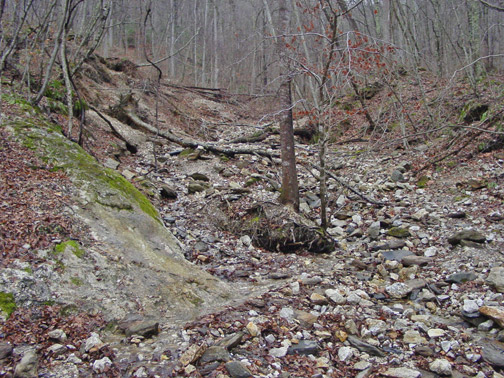
Ray Mine creek & lower spoil piles (looking east-northeast)
|
As was mentioned in the above notice, the shafts and cuts are surrounded and/or covered with brand new fencing replete with warning signs. The USFS went to a lot of trouble and expense to help ensure public safety.
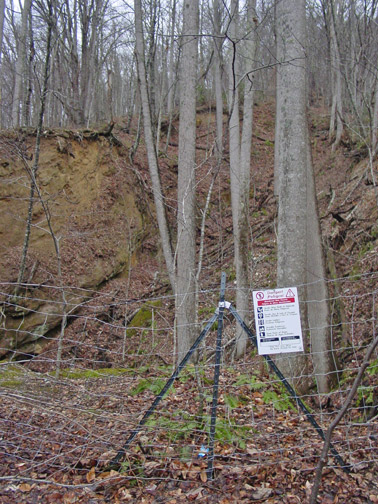
Briney Deep Cut & Shaft
(looking northeast)
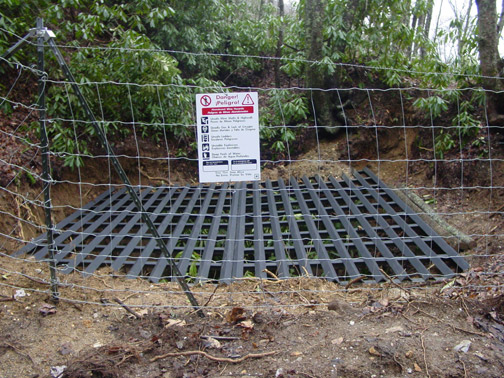
Dolph Hensley or Bailey Shaft
(looking east)
| |
We surface collected our way up to one of our favorite spots. I dug a little bit into the extensive spoil piles and whacked on boulders I believed most likely to contain beryl and other collectible minerals while Chrissy surface collected to find her keepers.
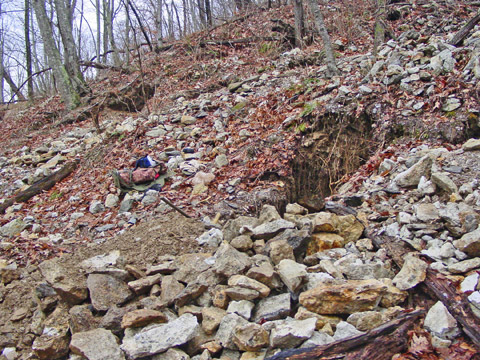
View of typical spoil pile excavation.
|
After a few hours of digging and banging, we found quite a few goodies and started back down the rocky slope toward the creek and eventually our waiting truck.
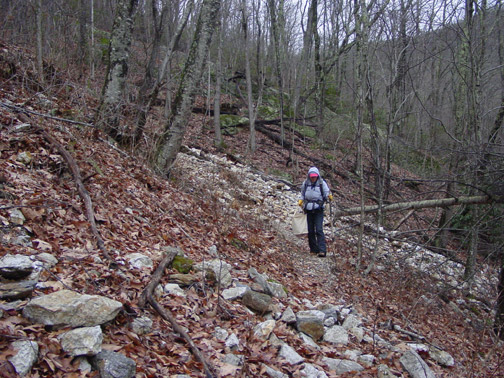
Chrissy on middle spoil pile cross trail (looking east)
|
We generally employ collapsible heavy canvas buckets to haul out our rocks and minerals. These buckets work well for the Ray because each can be carried flat in a backpack when not in use, which often happens after a day spent there.
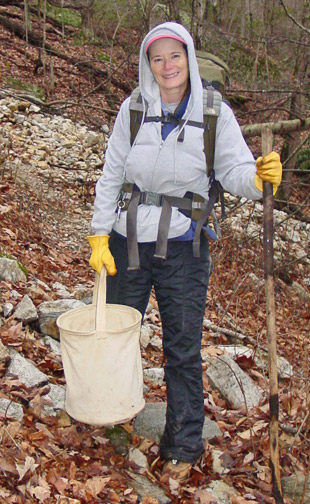
Chrissy Streeter
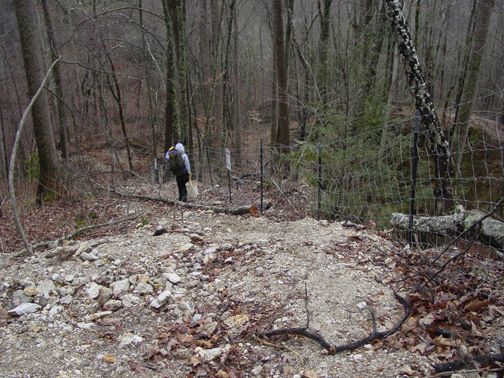
Chrissy heading down main east trail
(looking southeast)
| |
We keep our eyes to the ground until we make it back to the truck because you never know when just the right rain drop will wash off the last vestige of dirt to reveal a formerly-hidden killer crystal or cuttable rock specimen no matter where at the Ray.
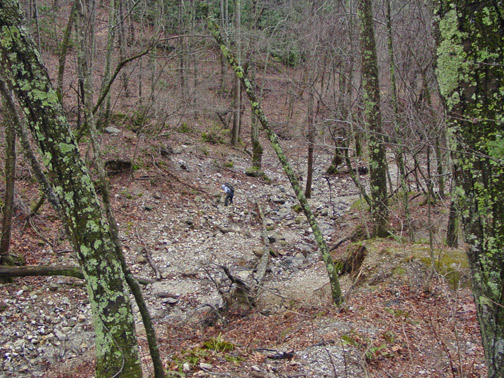
Creek from above (looking southeast)
|
Lady Ray again proved to us there is an unlimited number of fine rock and mineral specimens yet to be found. The following pictures show some of what we hauled out in our handy-dandy collapsible buckets.
- click on each specimen picture to enlarge -
Always productive Chrissy found one of the largest single columbite crystals we'd ever seen from the Ray (below left), while I had to settle for a spread out skeletal version (below right).
- click on each specimen picture to enlarge -
I always keep a keen eye open for moonstone as it makes for excellent lapidary material.
- cab pictures do not enlarge -
I also look for any rock that may produce an interesting caboochon; I especially like those with black sprays of tourmaline var. schorl on white and gray feldspar and quartz. One of the rocks I brought home had an almost unbelievable surprise. I collected the rock for its tourmaline, but by blind luck, I discovered a nicely formed beryl hidden inside while slabbing it on my rock saw - HA!!
- click on above specimen picture to enlarge -
I was able to make a few rare cabochons from the rock . . .
- cab pictures do not enlarge -
With assistance from Epoxy 330, I was able to create a bunch of other cabochons from some other schorl-bearing rocks we dragged home and one with pale amazonite and quartz with muscovite inclusions.
- cab pictures do not enlarge -
Hopefully everyone will adhere to the new rules and we all will be able to collect at the bountiful Ray for many years to come. There is really no reason to be digging along the creek anyway as there is far more to be had in the slopes above; besides, rockhounding legally always beats getting fined and/or arrested.